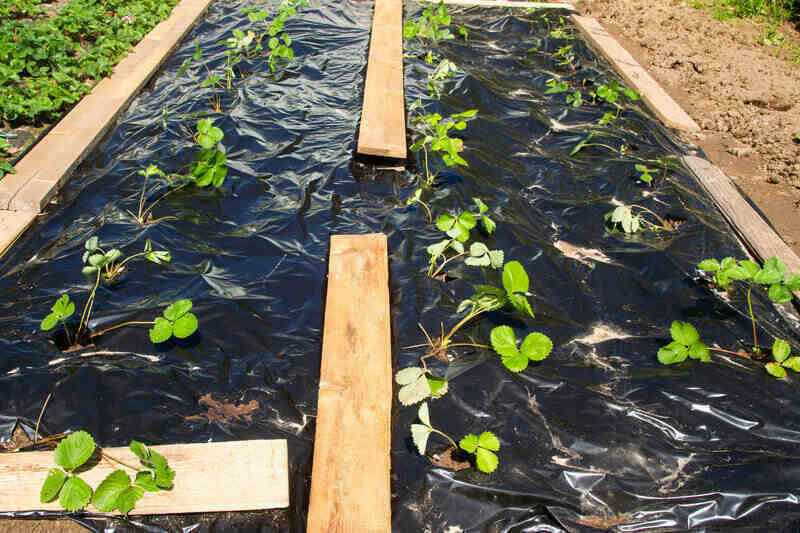
Landscape fabric can be a mighty weed blocker when used correctly, but installing the wrong type of fabric can ruin your hard work. If you want the best results for your landscaping project, it’s essential to know the different types of landscape fabrics and how to use them.
From your stone pathway to your vegetable garden, there’s a specific type of landscape fabric most ideal for your outdoor project. Let’s discover which kind will serve your needs best between woven, non-woven, spun, and perforated garden fabric.
What is landscape fabric?
Landscape fabric is a sheet-like material that comes in rolls. You can spread the material around your garden beds, trees, and shrubs to:
Landscape fabric (also known as garden fabric, weed block fabric, landscaping fabric, weed control fabric, and weed barrier fabric) is typically made of linen, polyester, polypropylene, or recycled materials.
Different types of landscape fabric
The four most common types of landscape fabric are woven, non-woven, spun, and perforated fabric.
Each type of fabric has distinctive characteristics which make them better suited for specific areas in the yard — thinking of installing non-woven landscape fabric around your veggies? Not so fast. Perforated landscape fabric might be the better choice for a weed-free garden.
Woven
Woven landscape fabric is typically made of woven linen or polypropylene. It contains small holes which allow water, nutrients, and air to access the soil.
This landscape fabric is best suited around trees and shrubs to help smother weeds. You also can use the weed barrier in flower beds that don’t need their plants changed often.
The fabric is tough to puncture and tear, so digging holes for new plants can be challenging. That’s why it’s not the best choice for a vegetable garden, as that’s where your green thumb gets the most exercise.
Non-woven
This landscape fabric is a solid sheet of non-woven material. It’s typically made of polyester or polypropylene.
The fabric allows some water movement, but it’s not as permeable as other landscape fabrics. When using non-woven fabric in your flower or vegetable garden, there is a higher risk of suffocating your plants.
So, where can you use non-woven landscape fabric? The best areas for your non-woven fabric are underneath rock mulches or rock pathways. Small stones often sink into the soil, making removing the stones or handling the soil especially difficult.
Non-woven fabric acts as a barrier between the soil and stones to help prevent the stones from sinking while also blocking sprouting weed seeds. When it comes time to remove the rocks, the fabric makes them easy to collect.
Spun
Spun landscape fabric is a type of non-woven fabric consisting of long polyester fibers that have been bonded together with compression or heat. Some spun landscaping fabrics are thin enough to exchange water and nutrients between plants and soil, but the thick spun fabrics are not as permeable.
You can use thin spun fabric in flower beds where digging is minimal, but it’s not the number one choice for vegetable gardens. Many gardeners use the heavy-duty material as a physical barrier around their gardens’ borders to deter destructive pests and invasive grass.
Thick spun fabrics are ideal underneath gravel mulches and pathways. They are also so strong and durable that you can install them behind retaining walls to ward off plant roots and prevent soil from seeping through the cracks.
Perforated
This landscape fabric has small, perforated holes. It’s a lightweight option perfect for areas that receive minimal foot traffic and where you change plants often.
Perforated landscape fabric works best in the vegetable garden or flower bed, including beds where you dig the soil often. Perforated fabrics are easy to tear if you need to dig in the ground, and many perforated fabrics come with precut holes for your plants.
The fabric’s small holes allow water, oxygen, and nutrients to seep into the soil while still blocking weed growth.
Because perforated fabrics are lightweight and light-duty, they are not ideal for areas that have heavy foot traffic or large roots.
Is landscape fabric right for my yard?
Landscape fabric can be a great benefit to the garden, but the weed control barrier has its pros and cons.
Permeable landscape fabrics will often clog and suffocate beneficial insects living in the soil, such as earthworms. Over the long term, even the best landscape fabric can prove harmful to plant and soil health.
The fabric also doesn’t add any nutritional value to the soil. Landscape fabric alternatives like newspaper, wood chips, and other organic mulches control garden weeds, limit erosion, and enhance soil moisture –– all while adding nutrients to the soil.
Depending on what your needs are, landscape fabric might be the optimal choice for your yard. For instance, if you’re installing a retaining wall, rock mulch, or a gravel pathway, it’s wise to install landscape fabric too.
Worried about installing your landscape fabric properly? Hire a local lawn care professional to install the material for you. Handing the job over to a pro can save your plants (and soil) from a DIY disaster.
Main Photo Credit: Shutterstock


